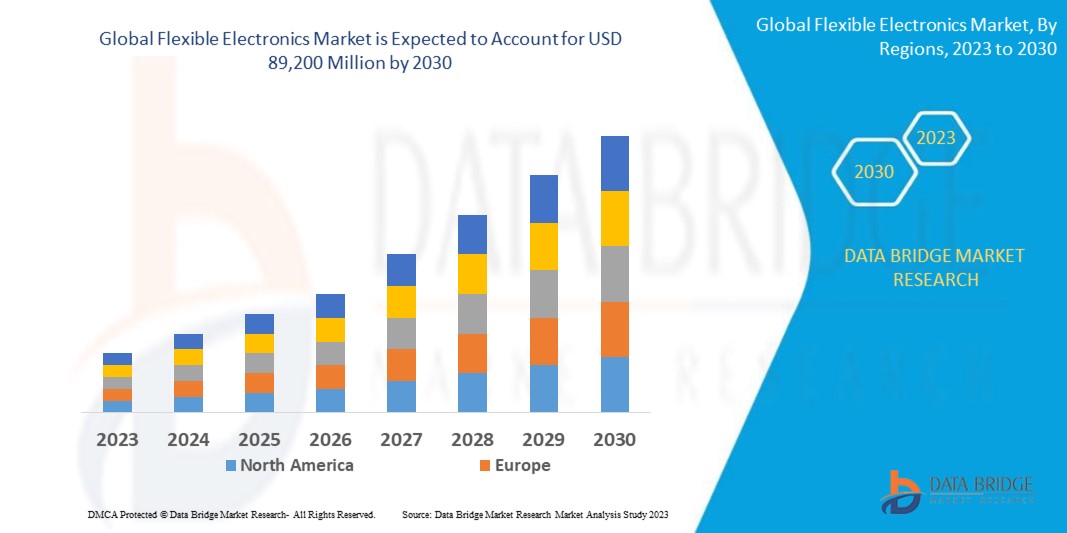Global Flexible Electronics Market
市场规模(十亿美元)
CAGR :
% 
 USD
31,700.00 Million
USD
45,045.00 Million
2022
2030
USD
31,700.00 Million
USD
45,045.00 Million
2022
2030
| 2023 –2030 | |
| USD 31,700.00 Million | |
| USD 45,045.00 Million | |
|
|
|
|
全球柔性电子市场,按组件(显示器、电池、传感器、存储器等)、应用(消费电子、汽车、医疗保健、工业等)、国家(美国、加拿大、墨西哥、巴西、阿根廷、南美洲其他地区、德国、意大利、英国、法国、西班牙、荷兰、比利时、瑞士、土耳其、俄罗斯、欧洲其他地区、日本、中国、印度、韩国、澳大利亚、新加坡、马来西亚、泰国、印度尼西亚、菲律宾、亚太其他地区、沙特阿拉伯、阿联酋、南非、埃及、以色列、中东和非洲其他地区)划分 - 行业趋势和预测到 2030 年。
柔性电子市场分析及规模
全球柔性电子市场根据组件和应用进行细分。细分市场之间的增长有助于您分析利基增长领域和进入市场的策略,并确定您的核心应用领域和目标市场的差异。
Data Bridge Market Research 分析,全球柔性电子市场在 2022 年为 317 亿美元,到 2030 年将飙升至 892 亿美元,预计在预测期内的复合年增长率为 19.1%。这表明了市场价值。“显示器”在全球柔性电子市场的组件部分中占据主导地位,因为显示器是各种电子设备(包括智能手机、平板电脑、可穿戴设备和汽车显示器)的关键组件之一。随着对这些设备的需求不断增长,对柔性显示器的需求也在增加。除了对市场价值、增长率、细分、地理覆盖范围和主要参与者等市场情景的洞察外,Data Bridge Market Research 策划的市场报告还包括深入的专家分析、按地理位置表示的公司生产和产能、分销商和合作伙伴的网络布局、详细和更新的价格趋势分析以及供应链和需求的缺口分析。
柔性电子市场范围和细分
|
报告指标 |
细节 |
|
预测期 |
2023 至 2030 年 |
|
基准年 |
2022 |
|
历史岁月 |
2021(可定制为 2015 – 2020) |
|
定量单位 |
收入(百万美元)、销量(单位)、定价(美元) |
|
涵盖的领域 |
组件(显示器、电池、传感器、内存等)、应用(消费电子、汽车、医疗保健、工业等) |
|
覆盖国家 |
北美洲的美国、加拿大和墨西哥、欧洲的德国、法国、英国、荷兰、瑞士、比利时、俄罗斯、意大利、西班牙、土耳其、欧洲其他地区、亚太地区 (APAC) 的中国、日本、印度、韩国、新加坡、马来西亚、澳大利亚、泰国、印度尼西亚、菲律宾、亚太地区 (APAC) 的其他地区、中东和非洲 (MEA) 的其他地区、巴西、阿根廷和南美洲的其他地区。 |
|
涵盖的市场参与者 |
三星电子株式会社(韩国)、LG Display 株式会社(韩国)、日本显示器公司(日本)、京东方科技集团股份有限公司(中国)、友达光电股份有限公司(台湾)、群创光电股份有限公司(台湾)、柔宇科技股份有限公司(美国)、E Ink 控股股份有限公司(台湾)、信利国际控股有限公司(香港)、天马微电子股份有限公司(中国)、夏普株式会社(日本)、维信诺科技股份有限公司(中国)、FlexEnable Limited(英国)、JOLED Inc.(日本)、Plastic Logic Germany GmbH(德国) |
|
市场机会 |
|
市场定义
全球柔性电子市场是指涵盖设计、制造和利用具有柔性并能适应各种形状和表面的电子元件和系统的行业。柔性电子利用有机聚合物、薄膜和柔性基板等先进材料来开发轻质、可弯曲和可拉伸的电子设备。这些设备应用于消费电子、医疗保健、汽车、航空航天等领域,具有便携性、耐用性和多功能性等优点。全球柔性电子市场的特点是技术不断进步、对可穿戴设备的需求不断增加以及柔性电子与物联网 (IoT) 的融合,推动创新并塑造电子设备和系统的未来。
全球柔性电子市场动态
驱动程序
- 对轻便便携设备的需求不断增加
消费电子、医疗保健和汽车等各行各业对轻便便携电子设备的需求日益增长。柔性电子产品具有轻薄、易用、可轻松贴合不同形状和表面的优势,非常适合重量、空间和便携性至关重要的应用。
- 柔性电子技术进步
柔性材料(例如有机聚合物、薄膜和柔性基板)的不断进步以及创新的制造工艺,大大提高了柔性电子设备的性能和可靠性。这些技术进步为柔性显示器、传感器、电池和其他电子元件的设计和生产开辟了新的可能性,推动了市场的增长。
- 可穿戴设备和物联网集成的需求不断增长
智能手表、健身追踪器和医疗监测设备等可穿戴设备的日益普及推动了对柔性电子产品的需求。柔性组件使舒适、不显眼的可穿戴设备能够无缝融入人体。此外,柔性电子产品与物联网 (IoT) 的结合为智能家居、医疗保健和工业自动化等各种应用领域的智能互联设备创造了机会。
机会
- 设计灵活性和耐用性的优势
柔性电子产品具有设计灵活性,可实现传统刚性电子产品无法实现的弯曲、可卷曲甚至可拉伸的外形。这种设计灵活性为产品创新和用户体验开辟了新的可能性。此外,柔性电子产品往往比刚性电子产品更耐用,因为它们可以承受弯曲、扭曲和冲击,非常适合需要坚固性和可靠性的应用。
限制/挑战
- 成本和制造挑战
与传统的刚性电子产品相比,生产柔性电子设备所涉及的制造工艺可能更加复杂且成本更高。使用专用材料、沉积技术和组装方法会增加生产成本,从而使柔性电子产品相对昂贵。此外,扩大生产以满足大众市场需求可能会在产量、可扩展性和成本效益方面带来挑战。
本全球柔性电子市场报告详细介绍了最新发展、贸易法规、进出口分析、生产分析、价值链优化、市场份额、国内和本地市场参与者的影响,分析了新兴收入领域的机会、市场法规的变化、战略市场增长分析、市场规模、类别市场增长、应用领域和主导地位、产品批准、产品发布、地域扩展、市场技术创新。如需了解有关柔性电子市场的更多信息,请联系 Data Bridge Market Research 获取分析师简报,我们的团队将帮助您做出明智的市场决策,以实现市场增长。
近期发展
- 2023 年 6 月,三星电子在 InfoComm 2023 上宣布推出其新的数字标牌系列,展示了使企业能够跨行业发展的创新显示器。亮点是虚拟制作墙,这是一款专用显示器,将超大 LED 墙与实时视觉效果技术相结合,减少了内容制作的时间和成本。此外,三星还推出了 QxC 系列水晶超高清标牌和 LED 一体机显示器,并为其智能标牌型号获得了碳足迹认证,展示了其对环境可持续性的承诺。
- 2023 年 1 月,LG Display 在 CES 2023 上发布了其最新的电视和显示器 OLED 面板,其最大亮度为 2,100 尼特,比之前的高端 OLED 面板提高了 60%。第三代 OLED 面板还通过使用微透镜技术和新算法,提供了更好的视角和功率效率。LG Display 将这套技术称为 META 技术,它可以提高各种设置下的亮度和可视性。
全球柔性电子市场范围
全球柔性电子市场根据组件和应用进行细分。这些细分市场之间的增长情况将帮助您分析行业中增长缓慢的细分市场,并为用户提供有价值的市场概览和市场洞察,帮助他们做出战略决策,确定核心市场应用。
成分
- 展示
- 电池
- 传感器
- 记忆
- 其他的
应用
- 消费电子产品
- 汽车
- 卫生保健
- 工业的
- 其他的
全球柔性电子市场区域分析/见解
对全球柔性电子市场进行了分析,并按地区、组件和应用提供了上述市场规模洞察和趋势。
全球柔性电子市场报告涵盖的国家包括北美的美国、加拿大和墨西哥,欧洲的德国、法国、英国、荷兰、瑞士、比利时、俄罗斯、意大利、西班牙、土耳其,欧洲其他地区,亚太地区的中国、日本、印度、韩国、新加坡、马来西亚、澳大利亚、泰国、印度尼西亚、菲律宾,亚太地区的亚太地区其他地区,沙特阿拉伯、阿联酋、南非、埃及、以色列,中东和非洲其他地区,以及南美洲的巴西、阿根廷和南美洲其他地区。
北美在全球柔性电子市场占据主导地位,因为该地区对柔性电子的需求不断增长,而可穿戴设备、智能纺织品和其他应用的日益普及推动了这一需求。亚太地区是柔性电池增长最快的市场。这是由于智能手机、平板电脑和可穿戴设备等消费电子产品越来越多地采用柔性电子,汽车和医疗保健领域对柔性电子的需求不断增长,以及该地区对研发活动的投资不断增加。
报告的区域部分还提供了影响市场当前和未来趋势的各个市场影响因素和国内市场监管变化。下游和上游价值链分析、技术趋势和波特五力分析、案例研究等数据点是用于预测各个国家市场情景的一些指标。此外,在提供区域数据的预测分析时,还考虑了全球品牌的存在和可用性以及由于来自本地和国内品牌的大量或稀缺竞争而面临的挑战、国内关税的影响和贸易路线。
半导体基础设施增长安装基础和新技术渗透
全球柔性电子市场还为您提供详细的市场分析,包括每个国家/地区资本设备医疗保健支出的增长、全球柔性电子市场不同类型产品的安装基数、使用生命线曲线的技术影响以及医疗保健监管情景的变化及其对柔性电子市场的影响。数据涵盖 2010-2020 年的历史时期。
竞争格局和全球柔性电子市场份额分析
全球柔性电子市场竞争格局提供了竞争对手的详细信息。详细信息包括公司概况、公司财务状况、收入、市场潜力、研发投资、新市场计划、欧洲业务、生产基地和设施、生产能力、公司优势和劣势、产品发布、产品宽度和广度以及应用主导地位。以上提供的数据点仅与公司对全球柔性电子市场的关注有关。
全球柔性电子市场的一些主要参与者包括:
- 三星电子有限公司(韩国)
- LG Display 有限公司 (韩国)
- 日本显示器公司 (日本)
- 京东方科技集团股份有限公司 (中国)
- 友达光电股份有限公司 (台湾)
- 群创光电 (台湾)
- 柔宇科技(美国)
- E Ink 控股股份有限公司 (中国台湾)
- 信利国际控股有限公司 (香港)
- 天马微电子股份有限公司 (中国)
- 夏普株式会社(日本)
- 维信诺科技股份有限公司 (中国)
- FlexEnable Limited(英国)
- JOLED 公司(日本)
- Plastic Logic Germany GmbH(德国)
SKU-
Get online access to the report on the World's First Market Intelligence Cloud
- Interactive Data Analysis Dashboard
- Company Analysis Dashboard for high growth potential opportunities
- Research Analyst Access for customization & queries
- Competitor Analysis with Interactive dashboard
- Latest News, Updates & Trend analysis
- Harness the Power of Benchmark Analysis for Comprehensive Competitor Tracking
研究方法
数据收集和基准年分析是使用具有大样本量的数据收集模块完成的。该阶段包括通过各种来源和策略获取市场信息或相关数据。它包括提前检查和规划从过去获得的所有数据。它同样包括检查不同信息源中出现的信息不一致。使用市场统计和连贯模型分析和估计市场数据。此外,市场份额分析和关键趋势分析是市场报告中的主要成功因素。要了解更多信息,请请求分析师致电或下拉您的询问。
DBMR 研究团队使用的关键研究方法是数据三角测量,其中包括数据挖掘、数据变量对市场影响的分析和主要(行业专家)验证。数据模型包括供应商定位网格、市场时间线分析、市场概览和指南、公司定位网格、专利分析、定价分析、公司市场份额分析、测量标准、全球与区域和供应商份额分析。要了解有关研究方法的更多信息,请向我们的行业专家咨询。
可定制
Data Bridge Market Research 是高级形成性研究领域的领导者。我们为向现有和新客户提供符合其目标的数据和分析而感到自豪。报告可定制,包括目标品牌的价格趋势分析、了解其他国家的市场(索取国家列表)、临床试验结果数据、文献综述、翻新市场和产品基础分析。目标竞争对手的市场分析可以从基于技术的分析到市场组合策略进行分析。我们可以按照您所需的格式和数据样式添加您需要的任意数量的竞争对手数据。我们的分析师团队还可以为您提供原始 Excel 文件数据透视表(事实手册)中的数据,或者可以帮助您根据报告中的数据集创建演示文稿。














